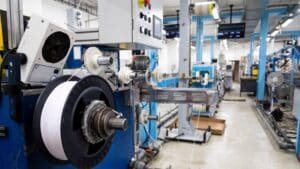Achieving impeccable prints begins with mastering the art of filament adhesion to the print bed. Whether you’re a seasoned 3D printing enthusiast or a newcomer, the key to success lies in meticulous attention to detail. Here’s an in-depth guide on how to ensure your 3D printer filament sticks flawlessly to your print bed:
- Precise Bed Leveling:
Start by meticulously leveling your print bed. An uneven bed can lead to inconsistent adhesion, causing issues like warped prints or uneven layer deposition. Utilize your printer’s auto-leveling features or perform manual leveling with precision. - Pristine Cleanliness:
A clean print bed is paramount for successful adhesion. Remove any lingering debris, dust, or remnants of previous prints. Using isopropyl alcohol or acetone, wipe the print bed thoroughly to eliminate oils and residues that may hinder adhesion. - Adhesion Aids:
Depending on the filament and print bed material, consider using specific adhesion aids to enhance bonding:
- Blue Painter’s Tape: Creates a textured surface for improved adhesion.
- PEI Sheets: Ideal for various filaments, offering excellent adhesion properties.
- Glass Beds with Glue Stick: Applying a thin layer of glue stick enhances adhesion on glass surfaces.
4. Optimized Bed Temperature:
Adjust the bed temperature to suit the filament type. Most filaments adhere better at elevated temperatures. Refer to the filament manufacturer’s guidelines for the optimal bed temperature range.
5. First Layer Settings:
Pay meticulous attention to first layer settings in your slicer software. Ensure the initial layer is slightly squished, optimizing contact with the bed. Adjust the nozzle-to-bed distance (known as Z height or Z axis) to achieve the desired level of adhesion. The optimal distance should allow you slide a piece of standard printer paper between the bed and the nozzle with very slight resistance on the paper.
6. Enclosure for Controlled Environment:
Consider using an enclosure for your 3D printer to create a controlled printing environment. This is particularly beneficial for filaments that require higher bed temperatures, ensuring consistent conditions throughout the print.
7. Heated Build Plate Benefits:
If your 3D printer is equipped with a heated build plate, leverage its advantages. A heated build plate significantly enhances adhesion, especially for materials like ABS. Experiment with different temperatures to find the sweet spot.
8. Exploring Print Bed Coatings:
Some users opt for specialized coatings such as BuildTak or similar products. These coatings provide an additional layer that facilitates adhesion and is easy to clean, offering a reliable surface for various filaments.
By incorporating these detailed tips into your 3D printing routine, you can elevate your printing experience and increase the likelihood of successful prints. Embrace experimentation with bed leveling, cleaning techniques, and adhesion aids to fine-tune settings that suit your specific printer and filament combination. Patience and persistence are your allies as you embark on the journey to achieve optimal adhesion and impeccable 3D prints. Happy printing!




